Republic of Armenia
| |
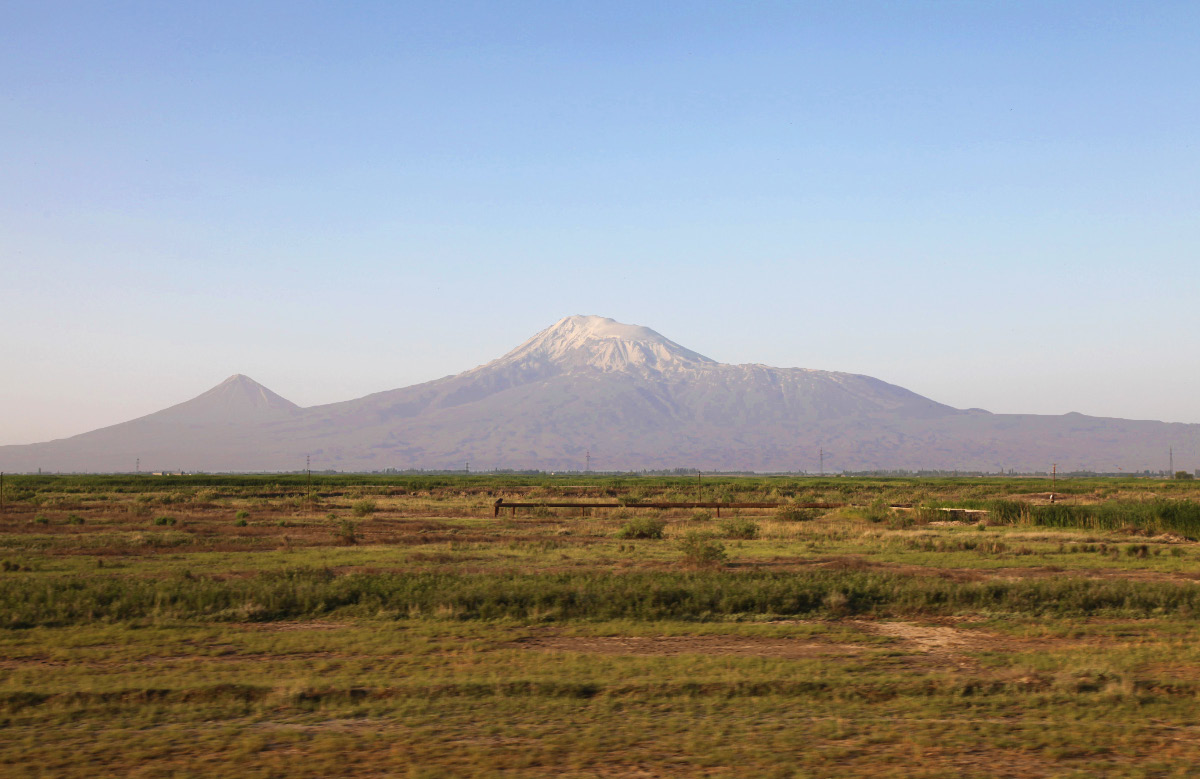 |
|
| |
|
|
| |
Արարատ – Mount Ararat |
|
| |
Աստուած յիշեց Նոյին, նրա հետ տապանում գտնուող բոլոր գազաններին, բոլոր անասուններին ու բոլոր թռչուններին։ Աստուած հողմ բարձրացրեց երկրի վրայ, եւ անձրեւը դադարեց։ 2Փակուեցին ստորգետնեայ աղբիւրներն ու երկնքի սահանքները, դադարեց նաեւ երկնքից թափուող անձրեւը։ 3Ջուրը գնալով իջնում, քաշւում էր երկրի վրայից, եւ հարիւր յիսուն օր անց այն նուազեց։ 4Եօթներորդ ամսի քսանեօթին տապանը նստեց Արարատ լերան վրայ։ 5Ջուրը մինչեւ տասներորդ ամիսը քաշւում էր, նուազում։ Տասնմէկերորդ ամսի առաջին օրը երեւացին լեռների գագաթները։ |
|
| |
|
ԳԻՐՔ ԾՆՆԴՈՑ 8:1-4 |
|
| |
But God remembered Noah and all the beasts and all the cattle that were with him in the ark. And God made a wind blow over the earth, and the waters subsided; the fountains of the deep and the windows of the heavens were closed, the rain from the heavens was restrained, and the waters receded from the earth continually. At the end of a hundred and fifty days the waters had abated; and in the seventh month, on the seventeenth day of the month, the ark came to rest upon the mountains of Ararat. |
|
| |
|
Genesis 8:1-4 |
|
| |
|
| |
Էջմիածնի Մայր Տաճար – Etchmiadzin Cathedral |
|
| |
|
|
|
|
| |
Well befitting a nation which became the first Christian state in 301 Anno Domini under the spiritual leadership of
Գրիգոր Լուսաւորիչ – Γρηγόριος Φωστήρ – Saint Gregory the Illuminator of Armenia (* c. 257, or as early as 240 – c. 331 †)
and the temporal kingship of Տրդատ Գ – Trdat (Tiridates) III the Great (* c. 250 – c. 330 †), the original church
was built on this location in that same year 301, and strikingly for all Christian Church architecture in the world,
the main structure of the present Cathedral building, though added to in later centuries, dates to 483-4 Anno Domini.
|
|
| |
|
|
|
|
| |
Սուրբ Հովհաննես Մկրտիչ Եկեղեցի – Saint John the Baptist Church |
|
| |
Վաղարշապատ – Vagharshapat – Etchmiadzin |
|
| Խոր Վիրապ – Khor Virap |
Հայոց ցեղասպանության զոհերի հուշահամալիր – Armenian Genocide memorial complex
built in 1967 on the hill of Tsitsernakaberd (Ծիծեռնակաբերդ) |
Գարեգին Բ – Catholicos Karekin II |
| Սասունցի Դավիթ – David of Sassoun |
Ամենայն հայոց կաթողիկոսներ – Catholicos of All Armenians (plural Catholicoi, due to its Greek origin) |
near train station Sasuntsi Davit
|
| |
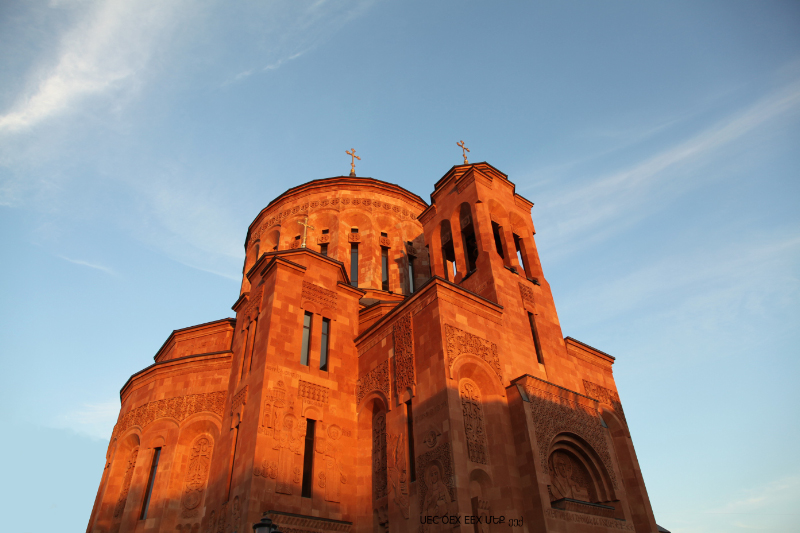 |
| |
|
Մոսկվայի հայկական վանքային համալիր - Армянский храмовый комплекс в Москве
Outstanding among all the peoples of European Christendom, are there any more heroic people of the Antemurale Christianitatis? Thank God for the Armenians. Слава Богу, для армян. Փառք Աստծո, հայերի համար.
Pictured is the Holy Transfiguration Armenian Cathedral of Moscow. |
|
| |
|
|
|
|
| |
But be careful of superlatives when applied to men and to their political inventions and achievements. |
|
|
|
| |
|
|
|
| |
Աստուած յիշեց Նոյին, նրա հետ տապանում գտնուող բոլոր գազաններին, բոլոր անասուններին ու բոլոր թռչուններին։ Աստուած հողմ բարձրացրեց երկրի վրայ, եւ անձրեւը դադարեց։ Փակուեցին ստորգետնեայ աղբիւրներն ու երկնքի սահանքները, դադարեց նաեւ երկնքից թափուող անձրեւը։ Ջուրը գնալով իջնում, քաշւում էր երկրի վրայից, եւ հարիւր յիսուն օր անց այն նուազեց։ Եօթներորդ ամսի քսանեօթին տապանը նստեց Արարատ լերան վրայ։ |
|
| |
|
ԳԻՐՔ ԾՆՆԴՈՑ 8:1-4 |
|
| |
|
|
|
| |
But God remembered Noah and all the beasts and all the cattle that were with him in the ark. And God made a wind blow over the earth, and the waters subsided; the fountains of the deep and the windows of the heavens were closed, the rain from the heavens was restrained, and the waters receded from the earth continually. At the end of a hundred and fifty days the waters had abated; and in the seventh month, on the seventeenth day of the month, the ark came to rest upon the mountains of Ararat. |
|
| |
|
Genesis 8:1-4 |
|
| |
|
|
| |
Higher in elevation than Mount Blanc of France and Italy (Elevation 4,810 m m / Prominence 4,696 m), though not as high as
Mount Elbris in Russia (Elev. 5,642 m / Prom. 4,741 m), Mount McKinley in Alaska (Elev. 6,194 m / Prom. 6,118 m), or
Aconcagua of Argentina (Elev. 6,961 m / Prom. 6,961 m), would many of us argue with the statement that Mount Ararat
is the most important mountain of European Christendom, except notably for the circumstance that the mountain
resting place of Noah's Ark lies on the Armenian Plateau lies in Asia Minor and within the boundaries of the nation-state
of Muslim Turkey? |
|
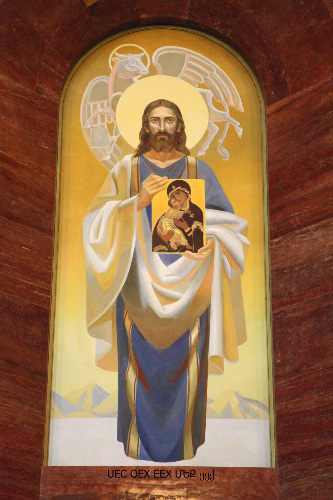 |
|
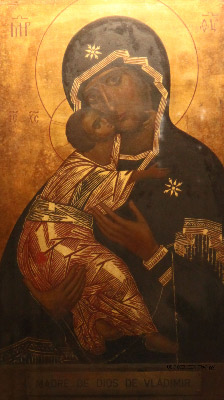 |
| Armenian Cathedral in Moscow |
|
Catholic Cathedral in Buenos Aires |
| |
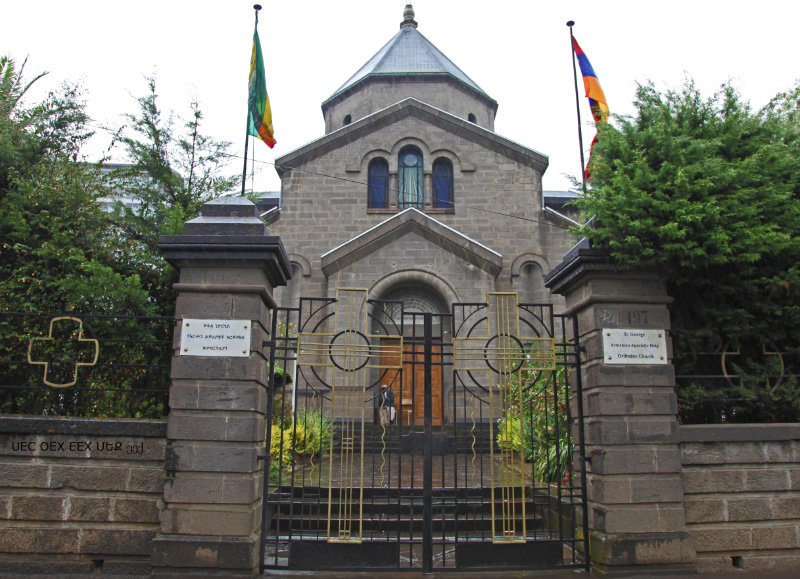
|
|
|
| |
|
Oriental Orthodox unity, Saint George Armenian Apostolic Holy Orthodox Church in Addis Ababa |
|
|
| |
|
Bleeding Armenia |
|
| |
|
|
|
| |
The cause of Armenia is founded on facts which exalt this people to the loftiest heights of martyrdom and have made them literally for eighteen centuries “The Blazing Torch of Asia.” Her tortures will not cease until the mailed hand of Christendom shall smite into the dust the power of the Prophet. The blood of probably a million martyrs to Christianity has drenched the soil of Armenia. Its fair proportions have been curtailed by conqueror after conqueror, its fields pillaged, its homes devastated and at no time has this devoted nation been without the presence of the sword suspended by the single hair. Embrace the creed of Islam, or the scimitar of the fanatic Moslem severs the hair which separates an existence of fear from the martyr’s crown, is forever in the thoughts of every Armenian. |
|
| |
|
|
|
| |
The historians of this people of Armenia claim for them a very ancient heritage—a career which though narrow, is one of thrilling interest. |
|
| |
|
|
|
| |
About the year 150 B. C., by the might of conquest a Parthian King came to the throne of Armenia; and wishing to know something of the origin of the race and of the history of the country, and not finding anything satisfactory in Armenia, he sent the most learned man in all his dominions to consult the old Chaldean manuscripts and tablets that were to be found in the Royal Archives of Nineveh. Every facility was afforded him in his search, and among the archives he found a manuscript written in the Greek characters with this label: “This book containing the annals of ancient history was translated from Chaldean into Greek by order of Alexander the Great.” He extracted from that the history of Armenia as written and continuing it down to his own times presented it to the King, who ordered it preserved with great care in his treasury. |
|
| |
|
|
|
| |
The principal sources of their national history rests upon the works of a celebrated Armenian writer of the fifth century, who claims to have derived his information from the above mentioned manuscript. They derive their parentage from Gomer, the son of Japhet, or rather from Haig, a grandson of Gomer, who moving northward from the plains of Shinar, settled with his families and followers in the country round about Ararat. This interesting story, which touches in many points the authentic histories of Nineveh and Babylon, cannot here be told; but we hastily sketch the succeeding eras in the ever fateful history of this primitive race of people. |
|
| |
|
|
|
| |
The grandson of the founder of this Parthian race of kings, Ardashes I., brought all Persia under his sway, and then turned westward with an army so vast he did not know their number. He subdued the whole of Asia Minor—passed the Hellespont, conquered Thrace and Greece, destroying many cities. Returning to Armenia, he planned another expedition into Persia in which he was defeated, wounded, and in dying, exclaimed, “Alas, how transient and unsatisfactory is glory.” |
|
| |
|
|
| |
A little later an immense army of allied Persians and Armenians invade Palestine and Phenicia, the Roman armies being unable to stop their progress. For an immense bribe of one thousand talents of gold, Antigonus secures their assistance in dethroning Hyrcanus and establishes himself upon the throne of Jerusalem. |
|
| |
|
|
| |
In the second year of Abgar (or Agbarus) (B. C. 3,) a decree was issued by Augustus that all the kingdoms acknowledging the Roman dominion should be taxed, and that statues of himself should be erected in the religious temples of every nation. Herod, King of the Jews, puffed up with pride, also sent statues of himself to be placed near those of Augustus. Abgar refusing to comply with this request, Herod sent a mighty force against him into Armenia, but the invaders were met and defeated with great loss. Abgar now determined to shake off the Roman yoke, and built the city of Edessa and strongly fortified it. Accused to Tiberius, the succeeding Emperor, of inciting the Persians to rebellion, he sent messengers to justify himself. |
|
| |
|
|
| |
During their stay in Palestine they heard all the wonders which were related to them of the extraordinary power of Christ. To gratify their curiosity they went to Jerusalem, witnessed the miracles performed by our Lord, and then returned to Armenia. Abgar, listening to their accounts, became satisfied that Jesus was the Son of God, and immediately sent back his messengers to Jerusalem with a letter to Christ in which acknowledging Him to be the true and only Son of God, he says: “Therefore, now I have written and besought Thee to visit me, and to heal the disease with which I am afflicted. I have also heard that the Jews murmur against Thee and are plotting to injure Thee; I have, however, a very small but noble state which is sufficient for us both.” |
|
| |
|
|
| |
The authenticity of this letter and the answer which Jesus sent in reply has been questioned: but truth is often stranger than fiction. Eusebius (Ecc’l Hist. Bk. I., chap. 13), declares that in the public registers of the city of Edessa these letters and records of the transactions following them were still to be found in his day. |
|
| |
|
|
| |
The story is that St. Thomas, directed by our Lord, wrote a reply to this letter, promising to send to them an apostle after His resurrection. Accordingly Thaddeus was afterwards sent to Edessa, where King Abgar was instructed and baptized. |
|
| |
|
|
| |
Many believed and were baptized. So gladly was the truth received, that tradition says that Bartholomew and Jude also were sent into Armenia, but later rulers apostatizing from the faith, began a fierce persecution. Bartholomew was crucified, the others also suffered martyrdom with multitudes of their disciples. |
|
| |
|
|
| |
Thus early was the infant church of Armenia baptized in its own blood, and for scarcely a generation has its blood ever ceased to flow. It is the martyr church and race of Christendom. Its persecutors have literally bathed themselves in the blood of the slain. |
|
| |
|
|
| |
Witness the horrible barbarity of a Persian Governor of Armenia in 1038, who, upon the capture of a city which had dared to rebel against their oppressors, was so wild with rage that he ordered all the Greek and Armenian captives to be slain; and when a trench that had been dug was filled with the blood of his butchered victims he satiated his revenge by bathing in it. |
|
| |
|
|
| |
In 286 A.D., there was a revival of Christianity in Armenia. Diocletian, Emperor of Rome, restored Tiridates to his throne, driving out the Persian usurper. With Tiridates there came from Rome Gregory the Illuminator. By his preaching of the Gospel the whole nation was converted to Christianity; and in the year 302 A.D., on the occasion of his going to Cæsarea Gregory was consecrated Archbishop of Armenia by Leontius the Metropolitan. Later, when the news reached Armenia that the Emperor Constantine was a convert, Tiridates and St. Gregory undertook the journey to Rome, when an alliance was solemnly agreed upon between the two nations. At the Council of Nice [Nicea], A.D. 325, the church of Armenia was represented by bishops who brought back with them the Creed of the Fathers. Thus the true light began to shine in fuller splendor in the midst of Cimmerian darkness. |
|
| |
|
|
| |
|
|
| |
The Armenians seem to have been born for sorrow. Their provinces were the highways of hostile nations. The armies of Rome and of Persia passing through always carried desolation and ruin with them. Compelled to yield to the demands of one conquering army, they became objects of vengeance to the other when the former had withdrawn. In the year 369, Shabuh, King of Persia, sent a large army against Arshag of Armenia, who, being caught in a fortress which could not stand a siege, determined to deliver himself to the Persian general with a view of pleading his cause before the king. |
|
| |
|
|
| |
Upon his arrival in Persia a palace was given him for his residence and that of his court. But Shabuh immediately compelled him to write to his Queen to join him in Persia; an order was also sent to the chiefs and nobles to proceed with their Queen to the Persian capital. |
|
| |
|
|
| |
The Armenian chiefs, alarmed at the order, begged to be excused, but the King being inexorable, they attacked the troops he had sent for their escort, put them to flight, and then fled into distant provinces. The Queen also taking the treasures of the royal palace retired to a strong fortress and wrote to Bab, a royal prince held as hostage at Constantinople, to raise an army of Greeks and hasten to the rescue of his father. |
|
| |
|
|
| |
Shabuh angry at these events caused Arshag to be loaded with chains and cast into the castle of Oblivion, where, once immured, no one was ever heard of again. |
|
| |
|
|
| |
The King of Persia sent a powerful army against the Queen headed by two apostate Armenians. They found the country in a most deplorable condition and at once laid siege to the fortress in which the Queen had sought safety. The siege became a blockade, until despairing of relief the inhabitants opened the gates and surrendered. The castle was plundered with horrible atrocities, while the Queen and captives who were spared were taken to Persia and by various and satanic methods of torture compelled to abjure their faith. Arshag, the imprisoned King, finding his bondage hopeless, driven to despair, fell on his sword and expired, having reigned eighteen years. |
|
| |
|
|
| |
Shabuh sent Merujan the apostate again into Armenia with a large army and a company of magi, promising him the sovereignty of the country if he succeeded in subduing the chiefs and in forcing the Armenians to embrace the Persian religion. A most dreadful persecution followed, priests and bishops and people were exiled, and multitudes put to death. All the books found in the country written in Greek characters were destroyed, and an order issued that no Armenian should learn that tongue, and that thenceforth all writings must be in the Persian characters. The magi and the executioners were distributed among the towns and villages, the miserable inhabitants having only the alternative of abjuring their religion or meeting instant death. |
|
| |
|
|
| |
This reads like a chapter of recent horrors. Finally Eastern Armenia became a province of Persia and after the death of Shabuh enjoyed a little tranquillity. At this time a certain Christian, Mesrob by name, became famous for sanctity and wisdom. He invented an Armenian alphabet, in the year 406. Learning began to flourish. Many schools were founded, and the Armenian youth were taught their language in their own alphabet. The Persian division of Armenia became celebrated throughout the East for its knowledge. The Old Testament was translated into Armenian from the Syriac, the New Testament having already been translated by St. Mesrob. |
|
| |
|
|
|
| |
|
|
| |
|
|
|
| |
|
from Bleeding Armenia, Its History and Horrors under the Curse of Islam, (1896)
By Rev. A. W. Williams and Dr. M. S. Gabriel
[Note well this work of warning was published nearly two decades before the (larger)
Armenian Genocide. Emphasis Added.] |
|
|
| |
|
Հայաստան - Միացյալ Եվրոպական Քրիստոնեություն՝ |
| |
|
Armenia - United European Christendom |
|